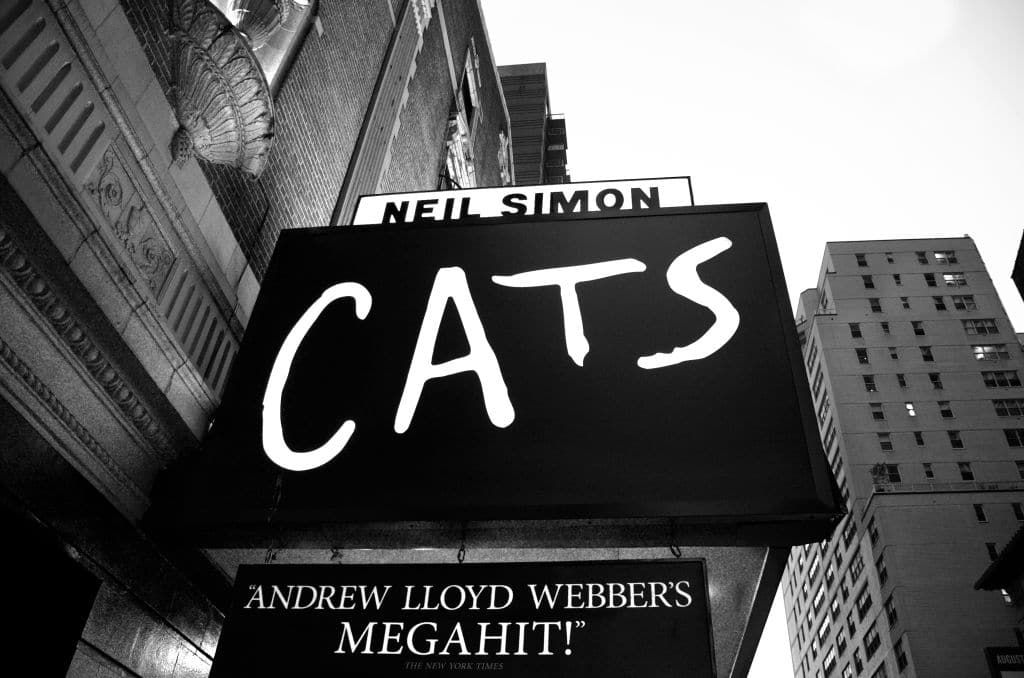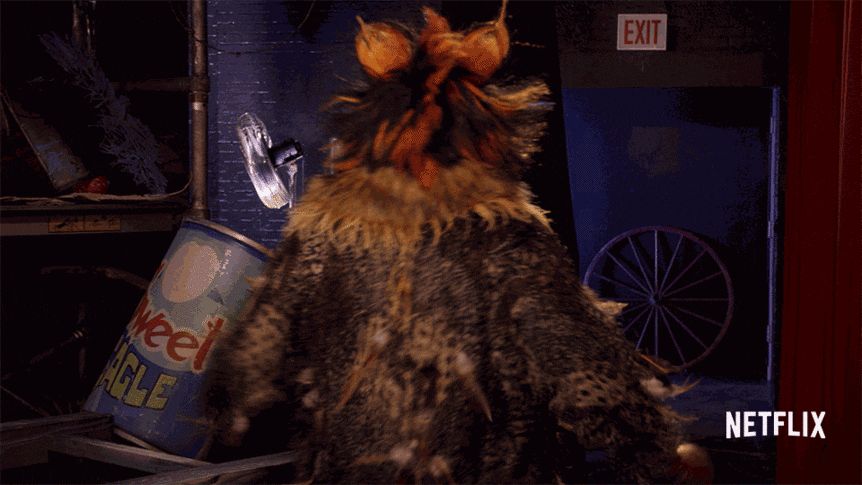Create a free profile to get unlimited access to exclusive videos, sweepstakes, and more!
Trying to explain Andrew Lloyd Webber's Cats

CinemaCon, an annual convention thrown by the National Association of Theater Owners, kicked off in Las Vegas a few weeks ago with the usual celebration of the big movies the industry expects to play well in cinemas nationwide. Attendees got glimpses of some long-awaited titles and updates on a few potential hidden treasures. As expected, movie lovers eagerly gobbled up the news on social media, from the unveiling of the first Joker trailer to much-hyped musical numbers from the latest live-action Disney remakes.
And then there was Cats.
The attendees of CinemaCon were not, sadly, treated to footage from the upcoming big-screen adaptation of Andrew Lloyd Webber’s wildly popular musical. Instead, they were given a sneak peek behind the scenes of the sets, which revealed that the colorful cast of felines will be shot to scale — meaning the humans will be filmed to look like they’re the size of actual cats — and that motion-capture animation will be used on the actors’ faces.
Twitter, of course, exploded. What the hell was this movie, and what was it going to look like? How do you make a big-budget movie out of a musical about cats? How the hell did they get Idris Elba, Taylor Swift, Ian McKellen, and Jennifer Hudson to sign on to this? And seriously, what the hell is up with Cats?!
In the world of musicals, Cats is a curious figure. The show is one of the most successful musicals of all time, having run on the West End stage for 21 years and its original Broadway run totaling 18 years. In its first 13 years of life, Cats reportedly grossed over $2 billion worldwide. It won seven Tony Awards and a Grammy and has been translated into more than 20 languages. Now, 38 years after its stage debut, Tom Hooper, the Oscar-winning director of The King’s Speech and Les Misérables, is bringing it to the big screen.
The flip side to that gargantuan success is the status of Cats as something of a pop culture joke. Everyone’s cracked a one-liner about men in leotards sniffing one another with glee. When a flaming parade float drove into the theater hosting the Broadway production of Cats in The Critic, Jay Sherman famously declared, “And nothing of value was lost.” The last season of Unbreakable Kimmy Schmidt featured an extended gag about Cats so genius that you wonder if Andrew Lloyd Webber will ever recover from such a sick burn. For people who hate musicals, Cats is the show they think of that proves their point. It’s a huge hit that’s seemingly loathed by more people than it’s loved by.
So, of course, it seems inexplicable that anyone would want to make it into a movie. Sure, we’ve all sung a few bars of "Memory" after a couple glasses of rosé, but do we need a whole film of that? Then again, given how much money the Mamma Mia! movies made and the seemingly never-ending influx of musical biopics we’re getting, why not go full Cats? It doesn’t hurt that, once upon a time, Cats was a very big deal, even a game-changing one.By 1980, Andrew Lloyd Webber was huge. The composer had penned two gigantic hits that dominated both the West End and Broadway stages: Jesus Christ Superstar and Evita. But he'd since fallen out with his usual lyricist, Tim Rice (who would go on to write Chess and songs for The Lion King), and wanted to try something different. Taking inspiration from one of his favorite writers, the poet T.S. Eliot, he decided to go down a more experimental route. Old Possum's Book of Practical Cats is a collection of poems that Eliot wrote as letters to his godchildren, telling the whimsical and melancholy tales of a gang of colorful felines with names like Macavity, Mr. Mistoffelees, and Rumpleteazer. The book isn’t tied together by plot or anything remotely resembling a linear narrative, but Lloyd Webber was keen to work with material he'd loved as a child, and he to this day remains a dedicated cat person.
To get the musical rights to the poems, Lloyd Webber had to go through Eliot's estate and his widow. Their stipulations for giving their blessing included a demand that only the original poems be used as the text for the book, meaning no new script, and for most of the rehearsals, that meant no plot. Many of the original cast admitted that, for the majority of the rehearsal period, they were convinced the show would be a total disaster. It had all the markers of a mess, and even with a creative team that included critical darling theater director Trevor Nunn and choreographer Gillian Lynne, the whole affair seemed too silly and out there for general audiences. How do you sell a mostly plotless show driven primarily by dance, featuring people in leotards singing made-up words?
For financiers, it was also a tough sell. Producer Cameron MacKintosh had trouble getting people to empty their pockets to fund what was becoming an increasingly costly show. At one point, Lloyd Webber told the creative team to go find their rich friends and get them to cough up some cash. He even turned to the cast of the show and asked if anyone would like to throw in a few bucks. The saving grace was seemingly the casting of Judi Dench, a theater legend in London who hadn’t quite become the grand dame of period dramas worldwide. She had agreed to play the role of Grizabella, but mere weeks before the show opened, she snapped her Achilles tendon during rehearsals. With their biggest star out of action, the creative team brought in Elaine Paige, who had become a West End superstar thanks to Evita. The benefit of her inclusion meant they had a proper belter to take advantage of, and the song "Memory" became the musical’s calling card, one that gave the show a chart-climbing single.
Then the show opened, and suddenly it was a commercial smash. While some critics celebrated Cats, others were less forgiving. Even Stephen Sondheim couldn't help but get a dig in at it, telling an audience at the Chicago Humanities Festival in 1995, "I remember going to Cats and wondering why they just didn't stack five million dollars on the stage." But by then, the show had made buckets of money and been produced worldwide. Andrew Lloyd Webber has never been the critics' darling, but for a while he had the Midas touch with the public. As one critic, Mark Steyn, noted, "Nobody liked it [Cats] but the public."So why is Cats such a big deal? At the time, it combined various styles of music and dance in a way that the British musical hadn’t really done before. It was a show that required a cast of triple-threat actors who needed to sing, dance, and act, and do all of the above while playing cats. The plotless nature of the show that rubbed so many critics the wrong way ended up being to their benefit in a burgeoning age of cheap air travel and the rise of tourism, with Cats playing well as an experience of emotion and visual excitement even if your audience is mostly made up of people who don’t have English as a first language. The music works better when you don’t think about the plot of characters. The plot, such as it is, doesn’t demand much of the audience. You don’t need to keep up with labyrinthine narratives or anything resembling the thematic density of Stephen Sondheim’s work. Just sit back and watch the pretty cats sing.
Most importantly, Cats is a spectacle. It’s a big-budget mega-musical made at a time when that sort of thing was coming to dominate the world of musical theater. Sure, having good music and a story is nice, but giving your audiences real bang for their buck was where it was at. Fans wanted to see that money on the stage. The mega-musical power of Cats expanded beyond the show itself. It was the first musical of its kind that was essentially made to order, ready for tours and international productions that would replicate the show completely for audiences across the world. The way it was marketed became hugely influential too, with the cat's-eyes logo becoming a merchandising dream allowing every fan wearing one of the show's t-shirts to become a walking advertisement. You may not have liked Cats, but for a while it was inescapable.
And that pop culture omnipresence has lasted decades. Long after it closed on Broadway and the West End, Cats was kept alive through cover songs, memes, amateur productions, and every musical composer who has wanted to replicate that magic of high-concept universal appeal. So, of course, there has to be a movie of it. No, it doesn’t need to make sense either. Indeed, it may prove even more intriguing to potential audiences if they go in with no idea of what’s happening. Personally, I’ve found that’s the best way to experience Cats. So strap in for Christmas and prepare for mo-cap madness. You know you’re going to end up seeing it anyway.
The views and opinions expressed in this article are the author's, and do not necessarily reflect those of SYFY WIRE, SYFY, or NBC Universal.



























